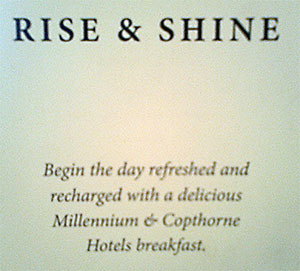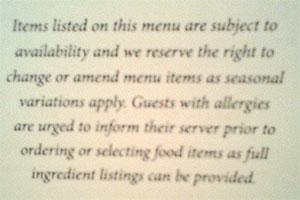Plain English Patrol 3
Recently, I stayed at the Millennium Madejski Hotel in Reading. (It’s handy for Legoland.) I have a secret liking for ultrabeige artificial environments like that, so I was happy enough – until I began idly browsing the menu over breakfast. The front read as follows:
Rise & Shine
Begin the day refreshed and recharged with a delicious Millennium & Copthorne Hotels breakfast.
Not spectacular, but I can’t really argue with it. It totally does the job for the brand, the situation and the audience, and I’m sure I would have written something very similar.
On the back of the same menu, however, the tone of voice takes an abrupt left turn:
Items listed on this menu are subject to availability and we reserve the right to change or amend menu items as seasonal variations apply. Guests with allergies are urged to inform their server prior to ordering or selecting food items as full ingredient listings can be provided.
We’re used to seeing different tones of voice for different purposes or situations. After all, real people vary their tone all the time – the tone I take when meeting a client in their office will devolve dramatically if we go out for a drink later on.
And when writing for a brand, it’s completely natural to strike a different tone in ‘selling’ and ‘official’ content – a good example being the contrast between a website’s home page and its terms and conditions.
However, the variation in our desired tone of voice may not map neatly on to the different elements of the customer’s experience. It may be that things we see as separate, or want to treat in different ways, are closely related in terms of user experience, purchase cycle or brand touchpoints.
For example, the hotel guest may be pleased to learn that the breakfast will refresh and recharge them, but immediately anxious for reassurance about their nut allergy. For them, the whole value proposition hinges on the small-print stuff.
If we vary the tone too sharply between areas that are closely linked for readers, we may implicitly undermine trust and what NLP practitioners call congruence. In human terms, our text steps over the line that divides ‘smooth-faced’ from ‘two-faced’.
In my view, this menu is a case in point. It’s all smiles when it wants your money, but when it comes to what’s actually offered in return, it retreats into multisyllabic, passive-case formality. And these two tones are, quite literally, found on the two ‘faces’ of the printed format.
This is a classic instance of language as defence mechanism; of speaking without wanting to communicate. The officious bureaucrat erects spiky word barriers around accountability and commitment that few readers will want to negotiate (or be able to). Sadly, it’s an approach that gets used far too often, particularly in the public sector.
Behind the bluster, the actual message is usually quite simple. Here’s a rewrite of the back-of-menu text:
Some foods aren’t always available. Please tell us if you have a food allergy; we can give you a full list of ingredients.
This reduces the reading age from the original’s 17 down to eight, greatly enhancing the odds that allergy sufferers will actually get the message they need to hear.
My version also makes it much clearer that the menu isn’t a promise – and it’s probably this clarity of obligation that makes people shy away from a simple, straightforward tone. Or maybe it feels like a simple tone just isn’t ‘hard’ or ‘important’ enough. But once you start reaching for the big words, you usually end up with a sledgehammer to crack a nut.
I’m not saying that everything should be written in exactly the same tone, regardless of its purpose. Instead, the tone should be as consistent as it can be, while still moving with the audience’s needs. We should write how people want to read.

